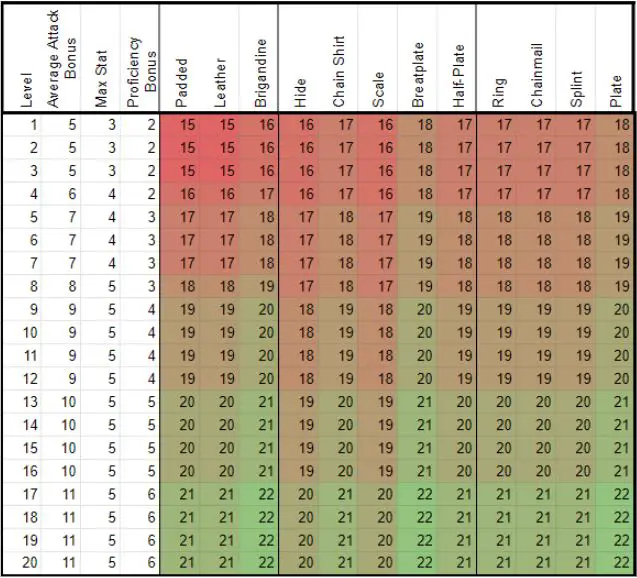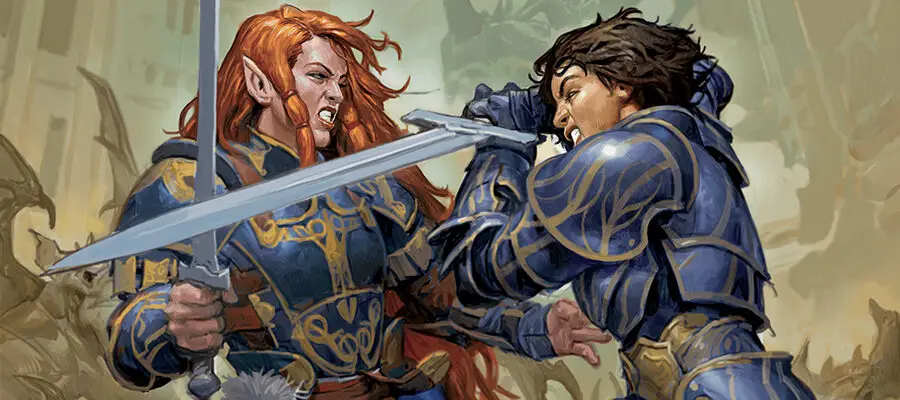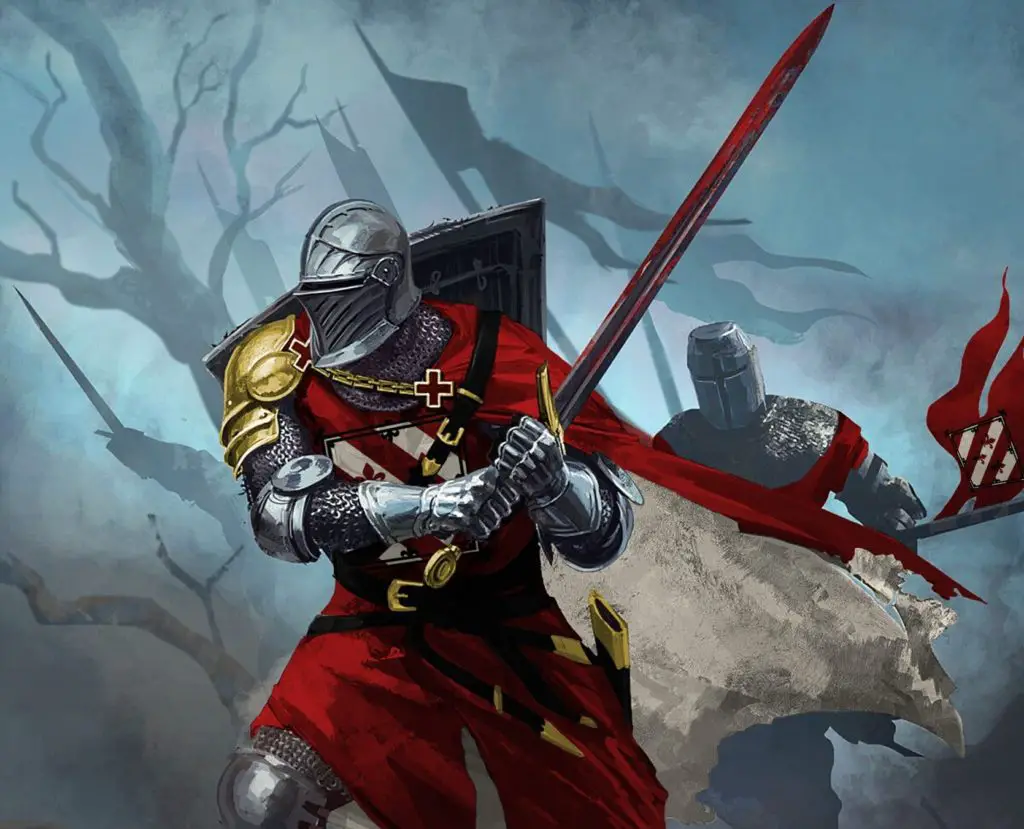D&D 5e armor reimagined featured image is from Fizban’s Treasury of Dragons. This article contains affiliate links that add gold to our coffers.
D&D 5e armor is simultaneously the most important and most boring decision that is made during character creation. After that, it is only considered whenever you’re leveling your character or after you bring in that big haul and can afford to upgrade. After a certain point below level seven, you’ll exhaust all armor upgrade options and don your last set of armor until the DM allows you to acquire or upgrade into magical armor.
There are twelve D&D 5e armors that are listed in the Player’s Handbook, twelve…can you name them all? When was the last time you considered using splint or ring armor after level five? Once you’re into mid-tier play, only three to four of the D&D 5e armors matter. Studded Leather, Chain Shirt, Breastplate, and Plate are the only armors that are used. Add in a Shield for good measure and your AC will never change again. This feels boring, doesn’t it?
Dexterity Is King in D&D 5e
Some of the most important decisions for optimization are made during character creation and affect a character every single session. It is an oft-accepted “fact” that Dexterity is the most important stat in the game. Strength-based weapons are viable if you’re going to be using heavy armor. Many characters settle for a fourteen in Dexterity and a shield compared to a fifteen in Strength to use the best heavy armor. Many will dip into Fighter to make that happen (also for action surge if you want the two-level dip).
When I ended my last 20th-level campaign last year, I noticed every single player character had either dumped Strength or kept it neutral. Their classes may have contributed to that, but that’s telling in its own way. When I asked them why they didn’t value Strength, it was a simple matter of Dexterity being the more important stat.
Dexterity can be used for damage, attack rolls, and AC as Strength can, but Dex can also be used for more ability checks and Initiative rolls. Looking at spells and monster abilities will reveal that Dexterity saving throws are far more common than Strength saves. Since Acrobatics can be used to escape grapples, even escaping a grapple won’t force a character to rely on Strength. Finally, ranged attacks are better in D&D 5e, and the best ranged weapons use Dex. I didn’t enforce encumbrance rules (many groups don’t), making Strength even less appealing.
Does it have to be that way? Why can’t I make interesting choices with D&D 5e armor and have those choices matter even into 20th-level gameplay? Why is it just so static after character creation?
I want to level the playing field between Dexterity and Strength.
Beginning to Rework the D&D 5e Armor System
Over the past year, I have refined a set of house rules surrounding D&D 5e armor that has changed the very core of my game and character mechanics. This stems from my experience designing encounters for 20th-level characters with epic boons, and then suddenly moving back to low-tier play. AC and armor mattered very differently in those scenarios. To-hit for monsters with CR over 20 are so ridiculously high that even the best-armored player characters were missed only if I rolled a 1 or a 2 on the d20 attack roll, and more came down to hit points and the ability to endure the punishment rather than avoiding the damage altogether through a relevant AC.
I somehow needed to keep AC at lower levels similar to what is expected now, make 20th-level AC matter, make armor more interesting to use, and consider different options. I needed to do all this using common mechanics that are easy to use and understand. We’ll see how I did. I’ll explain all of those rules later in the article.
First Step
I started with exploring using Strength as a modifier for AC, restricting that use behind actually wearing armor or using shielding equipment. The idea is that instead of dodging an attack, you block it and use your Strength to push it away. This was wildly successful; after running a short story arc where I introduced the idea, every single one of my players took advantage of this new mechanic, and my current arc has all Strength-based characters in the party. Just this simple correction has changed the game so much, and it is clear that there were several archetypes the players wanted to play that the mechanics just didn’t support.
After that, I developed the new D&D 5e armor properties. This is something that I still need to test more, and I’m hoping to get a lot of feedback and constructive criticism from the community. The core part of this is that I’m transitioning the current AC calculation from where it is currently, Base AC + Dex Mod (the reason that D&D 5e armor is so static) to Base AC + Proficiency Bonus + Dex/Str Mod.
Additionally, I added properties to differentiate each armor type from the others while trying to be as accurate to the historical uses as possible. We’ll need to get through our definitions first so we can all be on the same page. You don’t have to agree with my descriptions of the armor (I’m not a historian and I’m shooting from the YouTube hip on most of this). I’ll be explaining a bit more about mechanics and getting into the gritty details, adding in some fantasy aspects to the D&D 5e armor to spice things up.
D&D 5e Armor Types
Historically speaking, all armors had different advantages and disadvantages. With each successive advancement of weaponry and tactics, the armor evolved to better fit the most common scenarios faced by soldiers. Most of the ability for armor to be used in battle heavily depended on economics instead of viability. The rich nobility were the only wealth class able to afford Plate Armor and Barding for their mounts for a very long time. However, wealth being a limiter isn’t a viable tactic to restrict armor proliferation in a fantasy world, especially when many DMs don’t even pay attention to the cost column on the armor table (I’m guilty of it). Therefore, we need to set up mechanics as to why a character would wear one armor over another. However, first we need to better know what the armors of D&D are.
Light Armor
Padded: This armor is technically the most basic of armors, making its historical debut thousands of years ago. This armor can be made in dozens of different ways, from tightly woven wool and fabric to wicker weaves that are made to be donned over the body. It is extremely easy and cheap to make, and common armor for novices and commoners to wear. A question that I see new and old players alike inquire about is the disadvantage on Stealth checks for this armor. The padding isn’t generally made to account for mobility and will restrict joint movement. Padded armor is also used as a base layer in many metal-plated armors.
Leather: Hardened plates of leather specifically made to cover vulnerable points of the body. This armor is also cheap to produce, and the hardened leather plates can easily be replaced but only provide marginal protection from the harder metal weapons, unable to deflect direct assaults. The plates are made to free the joints for movement, but this leaves vulnerable points on the wearer for enemies to exploit.
Brigandine (aka Studded Leather): First, I’d like to address the elephant in the room. This has been misidentified as studded leather. The actual historical version of this armor is Brigandine. Learn more about brigandine’s usage and history with this Shadiversity video. Brigandine is a series of metal plate strips bound together on the outside with leather or fabric to generally cover the torso wearer. Because of the construction, this armor is very flexible, allowing for better mobility and movement.
Medium Armor
Hide: Hide suffers from the same issues that padded armor does. It generally isn’t made to account for movement of joints, and so restricts general Dexterity, hence the disadvantage on stealth checks. This is also an easy armor to produce as it basically is treated Hide from an animal or monster, cut and wrapped to fit the wearer.
Chain Shirt: This armor is relatively common as it is flexible and thin enough to be worn under clothing but not so restrictive that it is impossible to move. This versatile armor theoretically can be (not) seen being worn by many of the more affluent members of society as well as those that don’t want to be known to be armored.
Scale Mail: A step up from the Brigandine, this armor can be a set of leather or hide armor with small metal plates or monstrous scales fastened to the outside to harden it against attacks. This is the start of the more heavy and restrictive armors.
Breastplate: An iconic armor generally custom-made to fit a specific user. Similar to Brigandine in that it generally is used to protect the torso while allowing for greater mobility and movement. The breastplate armor is two solid plates of metal fastened together.
Half-Plate: This is a combination of a Brigandine torso armor and metal plates fastened to the limbs to increase protection. Light padded armor is worn underneath to prevent injury to the wearer.
Heavy Armor
Ring: This broad category typically consists of a leather or hide base with large rings of steel integrated into the base armor. The armor covers the whole body and can be quite cumbersome due to the weight.
Chainmail: Like a Chainshirt but covering the whole body including a hood over the head, the construction of the mail makes mobility difficult and will typically have a padded armor or something similar as a base to protect the wearer.
Splint: Similar to ring armor, this consists of metal or monstrous bone strips attached to a leather or hide armor base to increase resistance to attacks. Weight is a factor as the wearer is trading protection for mobility.
Plate: This armor is considered to be the apex of personal protection against physical attacks without using magic. This would consist of three layers (sometimes more or less depending on the design), a base layer of padded armor, a suit of Chainmail, and then custom-fitted plates that cover the body as much as possible. The only weak spots in the armor are where the joints are and the slits where it is necessary for the user to see.
Active Defense
Shield: This piece of armor is used to allow the users to actively block incoming attacks. It generally is a large piece of wood, metal, or both that is designed to cover a portion of the body.
Buckler: Smaller than a shield, this small defensive device is meant to allow greater flexibility in a fight with a lighter option than a cumbersome shield. Some even allow the off-hand to be used in two handed weapons.
Reinforced Bracers: Leather bracers that have plates fastened to them, operating similar to bucklers. They allow the user to block or deflect incoming blows from weapons.
Barding
Barding refers to building armor for warhorses and other mounts. In a fantasy setting, this could include just about anything.
How I Reimagine D&D 5e Armor
Alright, now it’s time for the more gritty part of the article. What new mechanics can be introduced to make armor an interesting choice for players to make while at the same time giving them more options when creating their characters. I’ll list out what I have found to be successful at my table and then maybe I’ll use some simple math to explain why I chose the numbers I did.
Strength Bonus to AC
This is a change that divided my players. They were either very skeptical or excited when I introduced the concept. I allowed a character’s Strength bonus to be added to their Armor Class when wearing Medium/Heavy Armor or using a Shield/Buckler/Reinforced Bracers. NOTE: The “Max Dex” modifier of the armor still applies, so if they are wearing Scale Mail they can only add up to two to their AC even if their Strength is 20 (+5).
This rule alone changed the dynamic so much. More and more players started to consider Strength as a viable option for character builds. Insomuch that my current arc has all of the player characters Strength-based.
Shields
On top of the fact that shields allow for your Strength to become an asset, I took away the flat +2 bonus that shields give to AC. When discussing this with a few of my players it would result in the fact that shields would only be used with light armor then, and that’s a fair point, so I decided to add in the brace ability. I’ve included full rewrites of the shields and the Shield Master feat in the next section.
Proficiency Bonus
In order to match up character level and AC better, I decided to add proficiency bonuses to any armor that a character is proficient in. It’s a simple change but a huge game changer for AC scaling, especially in the later game. PB evens things out for all classes at lower levels. To do this successfully, I needed to reduce the native bonus to AC that armor provides. See the next section for those numbers.
Armor Modifiers
Adding flat bonuses to certain armors will incentivize players to be pickier about their armor choice and hopefully will encourage them to think more than just choose the “best” armor and then never think about it again. These will be included in the next section.
Unarmed Strikes
Any armor that allows you to add your Strength bonus to your AC also allows you to make more deadly unarmed strikes, your unarmed attacks now deal 1d4 plus your Strength modifier and you are proficient in the attack if you’re proficient in the armor.
New Properties for Reimagined D&D 5e Armor
Instead of a flurry of new, shallow rules, I’m integrating my rules into properties for the armors. Okay, it’s an overhaul, but it’s worth it, I swear! The base AC calculation is (without armor) 10 + Dexterity modifier. All of the new properties are a lot to take in at first, but it’ll all make sense later.
Application
First I would like to address where these rules might fit well into a game. What really is important is the theme that you’re going for in how you would like the rules to change the feel and mood of each session. These rules put more emphasis on the different types of physical damage done to the players and give damage reduction as more of the advantage of wearing medium and heavy armors. AC becomes less important as the scores tend to be around 2-3 points of each other if scores are maximized during the mid-tier and upward. In this case, armor takes on more of a role of damage mitigation through resistances rather than improving the prevention of a hit.
This shift in mentality might be difficult to get used to at first, it will build complexity for your martial classes and will definitely expand on their options during and before combat. I would recommend this rule if you’re looking to add that complexity to what is generally a static set of bonuses and give a little more wiggle room for Strength to become a mainstream stat. The DM should be careful to include anything that would overpower armor or Strength, the AC scores being generally close with each other on purpose and the combination of significantly higher ACs with the damage reduction could skew the game in a direction that is no fun for anyone.
Properties
Adaptable Resistance: When worn and applied with a special magical reagent, this armor gains resistance to the type of damage listed by the reagent (See Alchemical Items).
Blocking: The wearer of this armor may use Strength or Dexterity when calculating AC.
Bulky: This armor is bulky and difficult to move in. Max speed is reduced to 15 ft. The wearer has disadvantage on all Dexterity checks and Strength checks.
Concealable: This armor can be hidden under clothing and can only be detected with a successful investigation check, DC equal to the base armor rating (i.e. 12 for Chain Shirt).
Limited Visibility: This armor is designed for defense. The design limits the senses. All perception and insight checks are made with disadvantage.
Resistance: When worn, this armor has resistance to the damage type listed.
Restrictive: This armor restricts normal joint movement. When worn, the wearer has disadvantage on all Stealth checks.
Shielding: (Brace Action) As an action the wearer may use this armor to give them half-cover, if prone or squatting three-quarters cover, and all ranged attacks made against them have disadvantage (for this purpose the sharpshooter feat and any effect that ignores cover will ignore the AC bonus but not the disadvantage since the user is actively trying to block incoming attacks).
Unarmed: This armor incorporates hardened elements that can be used to increase the damage of an unarmed attack; as long as the wearer is proficient with the armor, they are proficient with unarmed attacks made while wearing the armor, and all unarmed attacks deal 1d4 + Str modifier Bludgeoning damage.
Versatile: This armor incorporates other types of armor into its functionality. This armor can be donned as any of the other forms of armor listed.
Light Armor
Padded: 10 + Proficiency Bonus + Dex modifier; Properties: Adaptable Resistance, Restrictive.
Leather: 10 + Proficiency Bonus + Dex modifier; Properties: Slashing Resistance.
Brigandine: 11 + Proficiency Bonus + Dex modifier; Properties: None.
Medium Armor (Max Speed 40)
Hide: 12 + Proficiency Bonus + Dex/Str modifier (Max 2); Properties: Adaptable Resistance, Restrictive.
Chain Shirt: 12 + Proficiency Bonus + Dex modifier (Max 3); Properties: Concealable.
Scale: 12 + Proficiency Bonus + Dex/Str modifier (Max 2); Properties: Slashing / Piercing Resistance, Restrictive, Unarmed.
Breastplate: 13 + Proficiency Bonus + Dex modifier (Max 3); Properties: None
Half-Plate: 14 + Proficiency Bonus + Dex/Str modifier (Max 2); Properties: Adaptable Resistance, Bulky, Slashing / Bludgeoning / Piercing Resistance, Limited View, Restrictive, Unarmed, Versatile (Padded / Brigandine).
Heavy Armor (Max Speed 20)
Ring: 15 + Proficiency Bonus; Properties: Slashing / Bludgeoning Resistance, Restrictive, Unarmed.
Chainmail: 15 + Proficiency Bonus; Properties: Adaptable Resistance, Slashing Resistance, Restrictive, Unarmed, Versatile (Padded / Chain Shirt).
Splint: 15 + Proficiency Bonus; Properties: Slashing / Piercing Resistance, Restrictive, Unarmed.
Plate: 16 + Proficiency Bonus; Properties: Adaptable Resistance, Bulky, Limited View, Unarmed, Slashing / Bludgeoning / Piercing Resistance, Restrictive, Versatile (Padded / Chain Shirt / Breastplate / Chainmail).
Active Defense
Shield: No Bonus to AC; Properties: Blocking, Shielding, Unarmed.
Buckler: No Bonus to AC; Properties: Blocking, Unarmed.
Reinforced Bracers: No Bonus to AC; Properties: Blocking.
Barding
Barding: Matching AC Base + Riders Proficiency Bonus; Properties: Matching Armor used.
Alchemical Reagents
Certain armors allow for adaptable resistances based on consumable reagents available for sale, similar to potions for sale. Below are listed the different types of reagents available for use. Only one reagent may be applied to armor at a time. Progression for availability should match the availability of healing potions.
Simple Reagent (Common Potion) – These are sold as different kinds of paste that are applied to armor with the Adaptable Resistance property before it is donned. The reagent gives the wearer resistance to a single type of elemental damage (Acid, Cold, Fire, Lightning, Thunder) up to 10 points of damage prevented or a single area effect, whichever occurs first.
Greater Reagent (Uncommon Potion) – These are sold as different kinds of paste that are applied to armor with the Adaptable Resistance property before it is donned. The reagent gives the wearer resistance to a single type of elemental damage (Acid, Cold, Fire, Lightning, Thunder) up to 20 points of damage prevented or up to 2 area effects, whichever occurs first.
Superior Reagent (Rare Potion) – These are sold as different kinds of paste that are applied to armor with the Adaptable Resistance property before it is donned. The reagent gives the wearer resistance to a single type of elemental damage (Acid, Cold, Fire, Lightning, Thunder) up to 40 points of damage prevented or up to 4 area effects, whichever occurs first.
Supreme Reagent (Very Rare) – These are sold as different kinds of paste that are applied to armor with the Adaptable Resistance property before it is donned. The reagent gives the wearer resistance to a single type of elemental damage (Acid, Cold, Fire, Lightning, Thunder) up to 80 points of damage prevented or up to 8 area effects, whichever occurs first.
Other Rule Considerations with the D&D 5e Armor Overhaul
Mixing things up like Feats and Racial Features that better mesh with the new mechanics should be reviewed by the DM. An example of this is the Shield Master.
It seems like the shields property of Shielded overlaps the Shield Master feat quite a bit, but it doesn’t. The feat allows you to use an evasion-like ability indefinitely while the shield’s property uses a reaction to use. Below I propose the following addition to the feat.
Feat: Shield Master
You use shields not just for protection but also for offense. You gain the following benefits while you are wielding a shield:
- If you take the Attack action on your turn, you can use a bonus action to try to shove a creature within 5 feet of you with your shield.
If you aren’t incapacitated, you can add your shield’s AC bonus to any Dexterity saving throw you make against a spell or other harmful effect that targets only you.Removed due to changes.- If you are subjected to an effect that allows you to make a Dexterity saving throw to take only half damage, you can use your reaction to take no damage if you succeed on the saving throw, interposing your shield between yourself and the source of the effect.
- *You may use your shield to give yourself half-cover and disadvantage on ranged attack rolls made against you as a bonus action instead of an action.
*Changes made from original feat. Referencing the shielding property earlier in the article.
Magic Item Considerations
A secondary consideration that needs to be had is that certain magic items flatly increase ability scores. Such items will mess all of this up. The Belt of Giant Strength suddenly becomes a powerhouse for AC, attack rolls, and damage. Strength augmentations will likely become the most sought-after items in your game, especially if an Artificer is around. With that in mind I recommend changing up this item to the following:
“Giant Strength” Magic Items (Name, Strength Bonus, Rarity)

These changes will make it so that it will benefit characters the most that have already heavily invested in Strength and won’t wipe out a dump stat completely.
Mage Armor Adaptation for the New System
Mage Armor is another big one that needs to be addressed. It does need to scale with level, similar to the way that the new armor options work. This will need to be corrected if you don’t want to leave this useful spell behind.
Mage Armor 1st level abjuration
- Casting Time: 1 action
- Range: Touch
- Target: A willing creature who isn’t wearing armor
- Components V S M (A piece of cured leather)
- Duration: 8 hours
You touch a willing creature who isn’t wearing armor, and a protective magical force surrounds it until the spell ends. The target’s base AC becomes *10 + your Spellcasting Ability modifier + its Dexterity modifier. The spell ends if the target dons armor or if you dismiss the spell as an action.
*Changes from the original spell.
Math and Things for Nerds Regarding the D&D 5e Armor Overhaul
The new numbers flatten the AC of armors to better match standard average attack bonuses. This doesn’t include magic weapon and armor bonuses, but those should be added at the discretion of the DM. At 20th level, there will be a variation of three points between all armors, assuming all maximized stats. Magical modifiers are the same. This is done on purpose. It should be a choice between benefits and drawbacks.
There are clear winners for AC, and Plate Armor is still clearly the best when it comes to defense. However, there are other advantages when it comes to using Medium or low-AC armor. The resistances that the wearer gains could mean the difference between life and death. Secondly, there are winners in each category of armor. Breastplate is the best option for straight AC in medium armor. Half-plate is better for resistances. Brigandine is the clear winner for light armor if you don’t want to mess with the new mechanics at all. Below is a wonderful table outlining it all for all of you that work better with visualizations.
The average attack bonus is based on the maximization of numbers from a standard array or point-buy; these numbers will vary wildly once rolled stats begin to take effect.

How and Why I Overhauled D&D 5e Armor
Adding more options for armor will greatly benefit martial characters. Options give the armored classes versatility when it comes to looking for the benefits of one armor over the other. Flat bonuses and lack of variety made lack of money the only reason a character wouldn’t have plate armor. Adding heavy drawbacks to the best defensive armors forces characters to think twice about what armor works best. Next, the inclusion of Versatile Armors allows the martial classes more decisions and nuances during adventuring days. Owners choose which armor to wear. Instead of a heavier type, they can sacrifice damage resistances in exchange for greater mobility
The biggest change is the addition of specific damage resistances when it comes to physical damage. Bludgeoning, piercing, and slashing damage in D&D 5e have been interchangeable. Flat resistances (magic or not) to physical damage encourage players to consider armors that work best against common weapons. They carry a variety of weapons to counter specific armor types. Fighters need to deal with every damage type to exploit the weaknesses of all but the most heavily armored.
Benefits I’ve Experienced
Adding just these variations to Armor and AC will transform the way your players use armor. You’ll notice some players opt for Strength-based characters. They will ask what types of armor an enemy is wearing to know how to fight them.
The Armor Class will be more appropriate for encounter design. with AC and hit points being more important considerations for high-level encounters. While it still is possible for a large group of weak opponents to defeat a single heavily armored combatant, it is likely to last much longer and hopefully balance out the expectations of the encounter.
I have personally seen these rules bring so much positive change to my home game. The players become open to new and unique character concepts without feeling forced into a few character options. Strength has made a huge comeback! I’m seeing more variety in dump stats. Yes, now Dexterity can be a dump stat if you’re not a martial class. I hope that you would consider proposing this to your group and give it a try.
Until next time,
RPG StoryCraft aka Mike
If you’re interested in exploring other armor systems for D&D 5e, Flutes Loot highly recommends The Armorer’s Handbook: Equipment Upgrade and Rune Magic System by heavyarms on the DMs Guild. Cast Message in the comments to tell us us if you’ve used an alternative armor systems in your game and how it went!





Do you think giving b/p/s resistance is fair to the barbarians?
I think 20 feet movement restriction is too much, it basically means 1 wasted turn to get close to the enemy.
Hi Berkay, thanks for the thoughtful comment. The tradeoffs with armor vs the barbarian is the movement restriction. The barbarian has the advantage of getting resistances and fast speed, but there AC will never match someone wearing fullplate at high levels, which jives with the high AC/resistances/restrictions paradigm. It becomes more about what you as a player are willing to trade off.
I’m sure that a creative player will be able to think of ways around the speed restrictions, mine surprise me all the time 😄.
How would you adjust AC for creatures? Particularly those with levels? Just keep AC as is or rework as if they have armour, proficiency and Dex or Str modifiers?
From the author:
“AC is adjusted on monsters to match their difficulty for the encounter. Difficult encounters should be 20-30% hit chance and easy encounters should be 60-70% hit chance. Most players are able to get advantage for many of their rolls, so don’t let the high numbers fool you. After level 5, many players will be able to land hits frequently.
AC is then purely a factor of hit chance rather than damage mitigation. I compensate for this by giving the monsters natural resistances to certain types of damage, which will challenge your martial characters to improvise.
AC and HP is a matter of encounter design, it is a suggestion, not a rule. If your party has an average to hit of +6, then average encounters should have ACs in the 15-17 range. Difficult in the 19-21 range, and easy in the 13-14 range. No need to adjust based off the players rules.
Same thing with HP, if the party can pump out 80-100 HP of damage a round, then your encounter should have 400-500 HP to soak that up for a 5-6 round combat. Taking into consideration damage types and resistances”